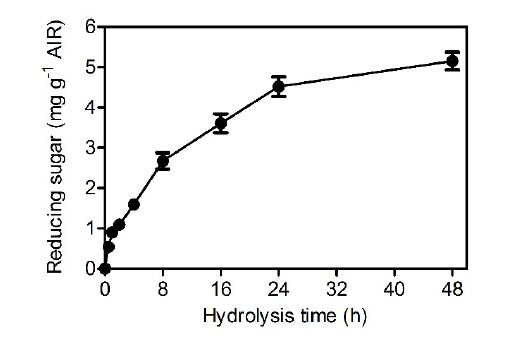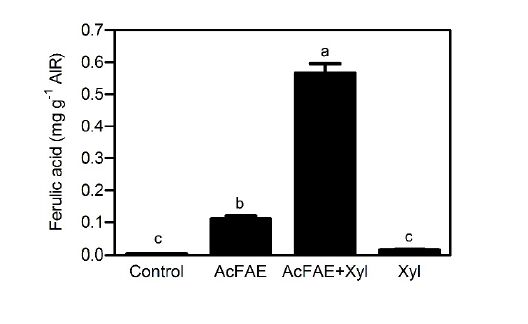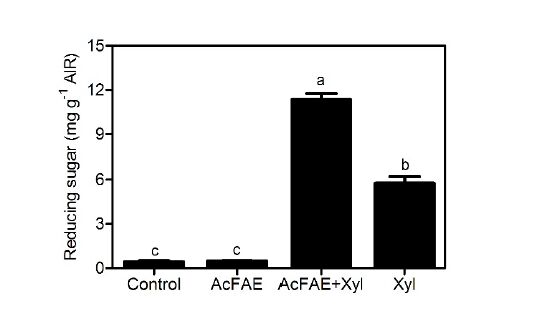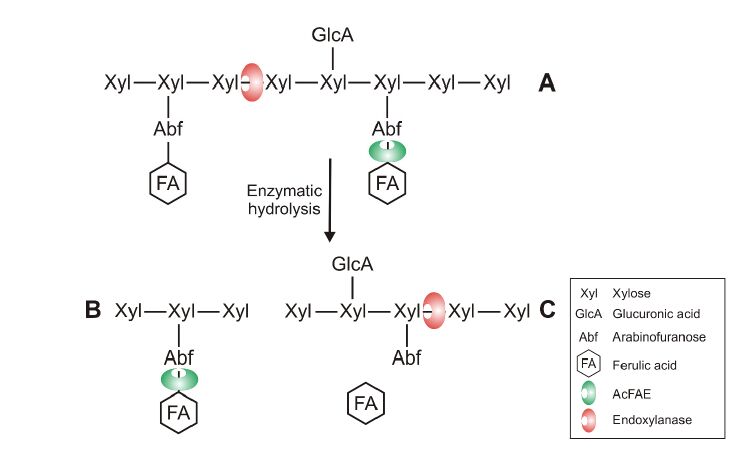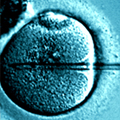1. Introduction
Lignocellulosic biomass is a large-scale feedstock for bioethanol production with the potential to replace gasoline in a reasonable horizon of technological development. Residues from maize and sugarcane are abundant sources of lignocellulose for bioenergy [1,2]. Cell wall polysaccharides of grasses are highly cross-linked by ester-linked ferulic acid (FA) dimers. Yeasts can produce ethanol from reducing sugars released from lignocellulose hydrolysis catalyzed by mild sulfuric acid treatment or polysaccharidases and accessory enzymes. Sugars released by acid catalysis easily dehydrate in low pH forming furfurals that limit the yield of fermentation [3]. In this scenario, enzymatic hydrolysis has emerged as the main technological platform to saccharification of lignocellulosic biomass [4,5]. The enzymatic hydrolysis presents potential for developing saccharification processes with higher yields, lower energy costs and milder conditions than chemical processes. However, lignocellulose is a complex crude matter and its complete degradation to fermentable sugars demand a complex enzyme consortium. The enzyme hydrolysis mechanisms and the relationship between structure and function of the various glycosyl hydrolases and accessory enzymes are not completely understood [5,6].
Cellulose and hemicellulose are the most abundant polysaccharides present in the lignocellulose. In grass cell walls, cellulose microfibrils are involved by arabinoxylan hemicelluloses, that restrict the access of enzymes to cellulose degradation [4]. Xylans of grasses have a backbone chain of β-(1→4)-D-xylopyranosyl units that may occur branched with glucuronopyranosyl, 4-O-methyl-D-glucuronopyranosyl, α-L-arabinofuranosyl (Araf), and acetyl moieties [7]. Ferulic acid esterifies the C-5 of Araf, resulting in a variety of xylan known as feruloylated glucuronoarabinoxylans (FA-GAX). Ferulic acid (FA) is hydroxycinnamic acid that comprises a lignin moiety known as non-core lignin. It polymerizes with core lignin monomers and with other FA residues. Therefore, FA anchors lignin in FA-GAX as well as cross-link vicinal FA-GAX. Such cross-linkages hinder the polysaccharide attack of hydrolases reducing the enzymatic hydrolysis efficiency [8].
Feruloyl esterase (FAE; EC 3.1.1.73) denotes a group with related enzymes that cleave ester bounds between hydroxycinnamoyl substrates and polysaccharides, or synthetic substrates. FAEs are classified into four subclasses: types A, B, C and D, based on their amino acid sequence, specificity for aromatic substrates and ability to release diferulic acid (predominantly 5,5'-diferulic acid) from esterified substrates. Type D enzymes are active on methyl ferulate, methyl sinapate, methyl p-coumarate and methyl caffeate, and can release diferulic acid from natural substrates [9].
Feruloyl esterases act synergistically with xylanases cleaving bonds between FA and arabinoxylans and, thus, improving the efficiency of cell wall hydrolysis [7]. Several studies have demonstrated synergistic actions between FAEs, xylanases, cellulases, pectinases and other accessory enzymes in the degradation of cell wall, releasing FA and diferulic acid from arabinoxylans or feruloylated polysaccharides [10,11,12]. Therefore, FAEs are biotechnological tools to potentiate the action of cellulases, hemicellulases and accessory enzymes to biomass degradation. In this work, we evaluated a feruloyl esterase type D from Aspergillus clavatus (AcFAE) over-expressed in Escherichia coli and its activity sole or in association with a xylanase in the saccharification of sugarcane bagasse (SCB).
2. Material and Method
2.1. Strain and culturing conditions
The Escherichia coli strain BL21 (DE3) was grown at 37 °C in lysogeny broth (LB) medium and used as hosts for over-expression of feruloyl esterase. The plasmid pET-28a (Novagen, Darmstadt, Germany) was used an as expression vector. The feruloyl esterase from Aspergillus clavatus (AcFAE) was previously cloned into pET-28a vector and biochemically characterized by Damásio et al. [13].
2.2. Expression and purification of AcFAE
Escherichia colistrain BL21 (DE3) was grown at 37 °C, 200 rpm in LB (Luria-Bertani) medium containing 50 mg/mL of kanamycin at 37 °C until OD600 of 0.6, and the expression of AcFAE was induced for 4 h by adding isopropyl-β-D-thiogalactopyranoside (IPTG) to a final concentration of 0.5 mM. Cells were pelleted by centrifugation at 8,000×g for 25 min and resuspended in buffer containing 50 mM Tris-Cl pH 8.0, 1 mM NaEDTA, 0.02% sodium azide (w/v), 10 mM dithiothreitol (DTT), and 2 mM phenylmethylsulfonyl fluoride. The cells were sonicated and incubated for 60 min at room temperature with 50 mM Tris-Cl pH 8.0, 1% Triton X-100 (v/v), 1% sodium deoxycholate (w/v), 0.3 mg/mL lysozyme, 100 mM NaCl, 0.02% sodium azide (w/v), 10 mM DTT, 0.02 mg/mL deoxyribonuclease and 2 mM MgCl2. The solution was frozen in liquid nitrogen and defrosting at 37 °C for 30 min. The solution was centrifuged at 11,000×g for 20 min at 4 °C. The pellet was washed three times with buffer containing 50 mM Tris-Cl pH 8.0 and 100 mM NaCl. The recombinant protein was dissolved in 6 M guanidine and 50 mM Tris-Cl pH 8.0, and was loaded onto a Ni2+-chelating affinity column (HiTrap, GE Healthcare) pre-equilibrated with 6 M urea, 50 mM Tris-Cl (pH 8.0), 300 mM NaCl, and 5 mM imidazole. Chromatography was carried out using a non-linear imidazole gradient from 5 to 500 mM in ÄKTA Protein Purification System (GE Healthcare). The protein fractions were pooled and dialyzed overnight at 4 °C against 6 M urea, 50 mM Tris-Cl pH 8.0, and 300 mM NaCl to remove imidazole. Hereafter, the sample was reduced with 10 mM β-mercaptoethanol for 1 h at 4 °C and diluted with 50 mM 3-cyclo-hexylamino-ethylsulfonic acid (CHES) pH 9.0, 10 mM β-mercaptoethanol and 10% glycerol (v/v). The protein was concentrated in stirred cell (5-kDa cutoff; Millipore) and then purified by gel filtration chromatography using Superdex 200 GL 10/300 (GE Healthcare) in ÄKTA Protein Purification System. The protein was eluted in 10 mM CHES, 50 mM NaCl and 5% glycerol (v/v). The AcFAE purification steps were monitored by UV absorption at 280 nm, SDS-PAGE 12% and esterase activity assessed against α-naphthylbutyrate.
2.3. Preparation of sugarcane bagasse
Sugarcane bagasse was obtained from Usina da Pedra (São Paulo, Brazil) and was washed with water, dried at room temperature and then milled to a fine powder in a ball mill. Samples (200 mg) were incubated in ethanol 80% (v/v) (20 min at 80 °C, 10 times) and centrifuged (8,500×g, 10 min) to remove soluble sugars. The alcohol insoluble residue (AIR) was used to enzymatic hydrolysis.
2.4. Enzymatic hydrolysis
Reaction mixtures were incubated at 30 °C contained 30 mg of AIR, 40 µg/mL of purified AcFAE alone or in combination with 25 U/mL of xylanase NS22083 (Novozymes, Brazil) and 0.1 M sodium phosphate buffer (pH 6.0) at the volume necessary to complete final volume of 1 mL. The supernatant was collected by centrifugation (12,000×g, 5 min) and the reducing sugars released were quantified with 3,5-dinitrosalicylic acid (DNS method), using xylose as standard, and FA was analyzed by high-performance liquid chromatography (HPLC). The degree of synergy (DS) was determined using the equation:
DS = (product released by AcFAE with Xyl)/(sum of product released by AcFAE and Xyl alone)
2.5. Alkaline extraction of FA
Ester-bound FA was extracted after mild alkaline hydrolysis [14]. In brief, 50 mg of biomass was homogenized with 50% (v/v) methanol and incubated at 80 °C for 90 min. After centrifugation (2,180×g, 4 °C, 15 min), the supernatant was discarded and the pellet was washed twice with 50% (v/v) methanol. The pellet was dried at 60 °C for 24 h. The dry cell wall was resuspended in 2.5 mL of 0.5 M NaOH and incubated at 96 °C for 2 h. The supernatant was acidified to pH 2.0 with 6 M HCl, centrifuged at 2,180×g, 4 °C for 15 min and then extracted twice with anhydrous ethyl ether. The ethyl ether extracts were combined and dried at 40 °C. The samples were resuspended in methanol/acetic acid 4% (30/70, v/v) and analyzed by HPLC. The samples were analyzed with a Shimadzu® Liquid Chromatograph equipped with a LC-10AD pump, a CBM-101 Communications Bus Module, a Rheodyne® injector, and a SPD-10A UV-VIS detector. Ferulic acid was separated on C18 column (250 mm × 4.6 mm, 5 µm; Shimpack CLC-ODS (M); Shimadzu®) with equivalent pre-column (10 × 4.6 mm). The mobile phase was methanol/acetic acid 4% (30/70, v/v) with a flow rate of 1.0 mL/min in isocratic mode. Absorption of FA was detected at 322 nm and quantified according to standard values.
2.6. Statistical design
Data were expressed as the mean of independent experiments ± standard error mean (SEM). The differences between the parameters were evaluated by means of the Tukey test and P ≤ 0.05 were considered as statistically significant.
3. Results and Discussion
3.1. Recombinant AcFAE over-expression and purification
The over-expression of AcFAE using E. coli BL21 produced an insoluble fraction. The inclusion bodies were isolated, solubilized and purified by affinity chromatography. After the refolding, the extract was concentrated and purified by gel filtration chromatography. The ORF of AcFAE (XP_001274884) encodes a protein of 272 amino acids, with a predicted molecular mass of 28,480 Da, consistent with the SDS-PAGE 12% analysis (Figure 1) and the small-angle X-ray scattering analysis (26 kDa) as previous reported by Damásio et al. [13].
The purified enzyme showed activity towards α-naphthylbutyrate (C4), a synthetic substrate for qualitative detection of FAE activity. Synthetic substrates differ from natural substrates in terms of the type, complexity and accessibility of the ester links, and their reactions are unlikely to reveal the action and mechanism on natural complex substrates. Therefore, the use of natural substrates, such as SCB, may provide results more representative of the conditions in bioprocessing.
3.2. Time course for SCB hydrolysis
Enzymatic hydrolysis of lignocellulosic biomass provides an indication of their digestibility and suitability for the processes designed for preparing cellulosic ethanol [15]. For this, we determined the production of reducing sugars after enzymatic hydrolysis (30 min to 48 h) of untreated SCB applying a commercial xylanase. Figure 2 shows the content of reducing sugars released over time. Xylanase activity released most of the reducing sugars accessible in 24 h.
3.3. Enzymatic hydrolysis of SCB
To investigate the ability of AcFAE to cooperate with an enzyme cocktail, we submitted SCB to enzymatic hydrolysis with AcFAE combined with a xylanase rich enzyme extract and compared the reducing sugars released jointly with the activities of the AcFAE or enzyme extract individually. AcFAE was able to release an amount of FA from SCB considerably higher in the presence of the xylanase extract (Figure 3).
The degree of synergy measures the ability of two or more enzymes to cooperate in the action one each other upon a substrate [16]. The bagasse treatment with AcFAE and xylanase rich extract released 5.13-fold more FA than AcFAE alone. Vardakou et al. [17] suggested that the main factor by which xylanase contributes with AcFAE activity is by producing short chain feruloylated xylooligosaccharides with less steric hindrances. We also compared the activity of xylanase extract on SCB with the activity of xylanase rich extract plus AcFAE. The combined activity revealed a degree of synergy of 1.97 (Figure 4). Once again, the main cause of the synergy is supposed to be removal of hindrances for xylanase to attack, AcFAE cleaves the ester bond between FA and its arabinosyl residue; it creates more sites for the hydrolysis of arabinoxylan, improving the availability of substrate epitopes for xylanase [11,18].
Ferulic acid is a key component in grass lignocellulose recalcitrance, including SCB [8]. Although the pretreatment with alkali is a cheap and simple method to extract hydroxycinnamic acids from plant biomass, salts produced after alkali neutralization hampered the subsequent hydrolysis [19]. As an alternative, FAEs can provide a clean and environmentally friendly route for extraction of FA from lignocellulosic materials [18].
The cross-linking of grass cell wall components through FA and diferulates decrease the efficiency of digestion. The insoluble nature of the substrate also imposes limitation on accessibility for the enzymes to promote the hydrolysis [20]. In Figure 5, we show a scheme illustrating the putative mechanism behind the synergic activity between AcFAE and xylanase. While the shorter feruloylated xylooligosaccharides release by xylanases makes the polymer more accessible for FAE, the production of FA free xylooligosaccharides by AcFAE makes it more accessible for xylanases. The enzyme synergy reduces the amount of enzyme that is necessary to achieve saccharification and the costs to produce ethanol from lignocellulose biomass [16].
3.4. Alkali extraction of FA
After AcFAE hydrolysis, we extracted the remaining FA from sugarcane bagasse by saponification and analyzed it by HPLC. We dubbed the FA released by saponification of total alkali extractable FA. It allowed us to determine the relative percentage of the FA released by AcFAE and xylanase treatments (Table 1). The treatment with AcFAE individually released 1.5%, while digestion with AcFAE plus xylanase released 7.7% of total alkali extractable FA. These data revealed that enzymatic hydrolysis released only a small fraction of total FA content in the cell wall. The main information, however, is that a 7.7% decrease in FA content was able to increase the bagasse hydrolysis in 97.3%. Besides its presence in GAX, FA occurs also linked to lignin, proteins and pectin. Feruloyl esterases act only on the FA ester-linked to C-5 from arabinosyl residues in the xylan, but not on the linkages between FA and other cell wall polymers [21].
Table 1. Comparison of degree of synergy to FA releasing and total FA alkali hydrolysable with values reported for other microbial FAEs.
| Microorganism |
FAE enzyme |
Xylanase applied |
Plant biomass |
Degree of synergy |
Total of FA saponificable (%)* |
Reference
|
| Aspergillus clavatus |
AcFAE |
Novozymes Fungal preparation |
Sugarcane bagasse |
5.13 |
7.7 |
This study
|
| Aspergillus niger |
AnFaeA |
Aspergillus tubingensis |
Wheat arabinoxylan |
3.95 |
4.9 |
[23]
|
|
Aspergillus niger |
AnFaeA |
Thermoascus aurantiacus |
Wheat bran |
ND |
9.8 |
[24]
|
| Trichoderma viride |
ND |
29.2
|
|
Cellulosilyticum ruminicola |
FaeI |
Thermomyces lanuginosus |
Maize cob |
1.10 |
ND |
[25]
|
| FaeII |
1.04 |
ND
|
| FaeIII |
1.33 |
ND
|
| Fusarium proliferatum |
FpFae |
Thermomyces lanuginosus |
Corn bran |
1.79 |
11.3 |
[26]
|
| Cow' rumen microbial metagenome |
RuFae2 |
|
Rice bran |
ND |
5.46 |
|
| GH 10 EX from Cellvibrio mixtus |
Wheat bran |
6.72 |
5.33 |
[12]
|
| Wheat-insoluble arabinoxylan |
2.72 |
1.82
|
| Corn fiber |
1.21 |
0.57
|
| Switchgrass |
1.38 |
0.15
|
| Corn bran |
1.19 |
0.14
|
| * % = (FA released by AcFAE activity / FA released by alkaline extraction) × 100. ND: not defined. |
Although some FA-GAX is supposed to be out of range of the AcFAE, the high amount of FA released by alkali treatment suggests that most of the insoluble FA is not linked to GAX, but to other polymers, mainly lignin. Based on a combined UV, FT-IR, 1H and 13C NMR spectroscopy studies in SCB, Xu et al. [27] concluded that only about half of the insoluble FA (44.0-55.0%) is esterified to the cell wall hemicelluloses, while the remaining half of the FA is etherified to lignin. The variations observed in FAE activity on the different substrates are mostly indicative of compositional and structural differences among the plant materials [24]. Faulds and Williamson [28] using FAE from Aspergillus niger alone, obtained a maximum of 4% of the FA present in wheat bran, while AnFAEA and AnFAEB also from A. niger released 1.8% and 4.8%, respectively, from pre-treated sugar-beet pectin after 24 h of incubation. This is in agreement with the substrate specificity of FAEA and FAEB for feruloylated oligosaccharide [29]. Using Rufae2 in different natural substrates, the highest recovery of FA was 5.46% in rice bran and 5.33% in wheat bran [12]. Our results suggest that for production of reducing sugars, the specific site of FA linkage is more important than the total amount of FA released, once releasing lignin linked FA, for example, will not improve the accessibility of digestive enzymes to polysaccharides.
4. Conclusion
Bioethanol from lignocellulosic biomass is a promising solution for the replacement of fossil fuels, since it reduces the CO2 emission by the transport sector and our dependence on non-renewable fossil fuels. This research assessed the synergistic effect of AcFAE with a xylanase rich cocktail on SCB, a natural and complex substrate. The application of AcFAE was effective in removing FA and its concomitant application with xylanase improved significantly the release of both FA and reducing sugars. Our study supports the benefits of using of natural and complex lignocellulosic biomass in the development of enzyme consortium for the use in biomass-to-bioethanol applications.
Acknowledgments
This work was supported by the National Council for Scientific and Technological Development (CNPq 442333/2014-5, 310186/2014-5 e 313244/2014-6).This work is part of the production of the Instituto Nacional de Ciência e Tecnologia do Bioetanol - INCT do Bioetanol (FAPESP 2008/57908-6 and CNPq 574002/2008-1).
Conflict of Interest
All authors declare no conflicts of interest in this paper.









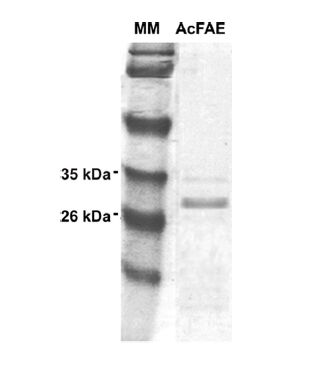
 DownLoad:
DownLoad: 